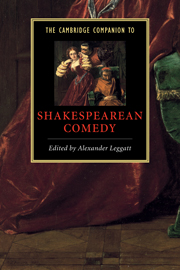4 - Elizabethan comedy
from Part 1 - Shakespeare and comic tradition
Published online by Cambridge University Press: 28 May 2006
Summary
“And where does the dog come in?,” the players in Shakespeare in Love keep asking. This is one of the film's running gags about setting supposed high art within the context of hard economic forces. Dogs pull the punters in, it is implied; so to be popular a play must have its dog and, by wider implication, its clown scenes. The joke is based on some truth. Several extant plays have scenes with dogs, and many more have their clowns. Some even incorporate bears. Mucedorus (1588-98), one of the most popular plays on the public stage, reprinted at least fifteen times over seventy years, has a scene early on in which Mouse, the clown, probably first played by the great Richard Tarlton, exits backwards tumbling over a bear, and Shakespeare's The Winter's Tale (1610) surely glances at this tradition in the famous stage direction that has Antigonus “Exit pursued by a bear” (3.3.58). Bears would not be difficult to get hold of, particularly as some playhouses did double duty as bear pits, but a bear part might sometimes be taken by a man in a bear suit. Mouse jokes about the probability that the bear rumored to be on the loose “cannot be a Beare, but some Divell in a Beares Doublet” (1.2.3-4). The joke could work either way, allowing for either a real bear or a man in a bear suit to collide with Mouse.
- Type
- Chapter
- Information
- The Cambridge Companion to Shakespearean Comedy , pp. 47 - 63Publisher: Cambridge University PressPrint publication year: 2001
- 1
- Cited by



